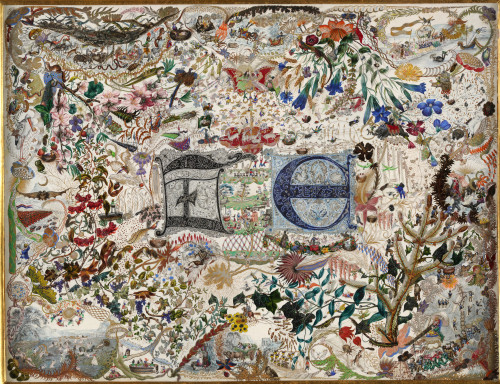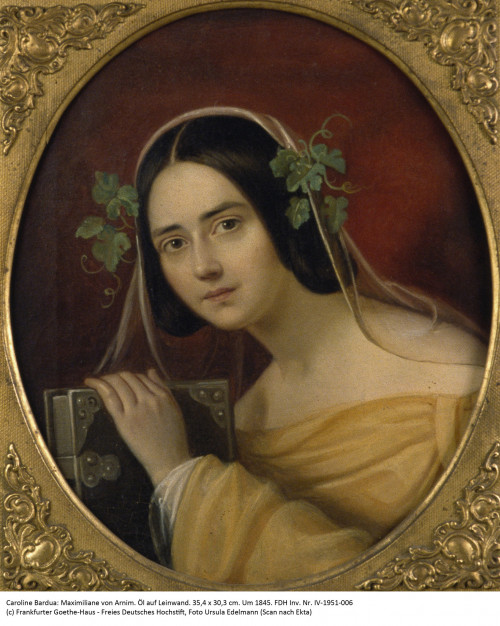A passage in a letter written by Bettine von Arnim is the reason the floor in this installation is designed like a chess board. In 1840, she had demanded: “a good king must place himself in check at every turn”. The Prussian people attached great hopes to Friedrich Wilhelm IV’s accession to the throne in June 1840. And Bettine von Arnim, who had already corresponded with him before that, also placed high expectations on the new king.
On the occasion of the enthronement, the new royal couple received tributes from all sides — also from the von Arnims, a noble family from the Mark Brandenburg. Achim and Bettine von Arnim had seven children: four sons followed by three daughters: Maximiliane, Armgart, and Gisela. Between the two chess opponents — the king and Bettine von Arnim — this installation features portraits of the von Arnims’ imaginative daughters painted by Caroline Bardua.
The practiced miniature painter Armgart von Arnim started work on an arabesque in honour of the king and queen in 1840, and her sister Maximiliane wrote an explanatory poem to accompany it. On 29 May 1843, the Arnim daughters were permitted to present their work to the king at Sanssouci Palace in Potsdam.
The richly detailed miniature painting depicts Friedrich Wilhelm IV and his wife Elisabeth as a fairy-tale couple. They are seated on a butterfly throne located at the centre of the composition, above their initials F and E. At their feet is an elven court — the king had a penchant for fairy stories. The work is full of richly allusive scenes tied together by winding arabesques. If you explore it with the magnifying glass, you can study all the tiny motifs, accompanied by further explanations.
Friedrich Wilhelm IV failed to fulfil the ideal of a fairy-tale ruler. The von Arnim family were also aware of his shortcomings — as we know, for example, from the satirical fairy-tale Love Overcomes Mashed Potatoes dating from the same period. Here Gisela von Arnim and her husband-to-be, Herman Grimm — the son of the fairy-tale collector Wilhelm Grimm — caricatured the corpulent, pleasure-loving monarch.
Bettine von Arnim was especially outraged by the poverty and lack of freedom in Prussia. For this state of affairs, however, she blamed above all Friedrich Wilhelm’s advisors and not the king himself. Her socio-critical work This Book Belongs to the King confronted him with the misery outside the gates of Berlin. To draw up a comprehensive documentation of poverty in Prussia, she placed a newspaper ad in May 1844 calling for material. She received numerous replies describing the shocking conditions, particularly in Silesia, where the weavers staged a revolt against their exploitation a month later. Bettine von Arnim was never able to complete her book. She had been given to understand that the state would not tolerate its publication, and that noncompliance would result in imprisonment. The dedicated supporter of the 1848 revolution had wished for a “people’s king”. Friedrich Wilhelm IV never fulfilled that wish.
Objects
-

ARMGART VON ARNIM
Oberon und Titanias Feenhuldigung, 1843
-

CAROLINE BARDUA
Maximiliane von Arnim; Armgart von Arnim; Gisela von Arnim (um 1840/43)
-
GISELA VON ARNIM / HERMAN GRIMM
Liebe überwindet Kartoffelbrei. Freßmärchen von Carl Anbiss (vor dem 10. Juni 1843)
-
BETTINE VON ARNIM
Nachweis der verarmten und hülfsbedürftigen Personen und Weber-Familien bei der Gemeinde Dittmannsdorff Waldenburger Kreises, 8. März 1844